
Binance Has a Major Pegging Problem
Trying to decipher Binance’s maze of finances is not for the faint-hearted.
Further investigation into Binance’s pegged-token “scheme” has revealed an alarming gap between the amount of tokens circulated on Binance’s BNB Smart Chain and the amount of actual tokens that they’re backed by.
One of the earliest criticisms leveled against Bitcoin when it started making the rounds in investment circles, was that it wasn’t “backed” in the traditional sense.
Why would anyone buy Bitcoin?
After all, Bitcoin isn’t a derivative of a commodity, not a lien on an asset, can’t be viewed as a mortgage on real estate, and it’s certainly not backed by the promise of a government.
Yet despite all of these criticisms, there has been no shortage of investors willing to plonk real sums of money to buy Bitcoin, presumably because there will be a finite supply and perhaps as a hedge against the largesse of the government.
Whatever the investment case (or lack thereof) for Bitcoin, it’s hard to make a case that it’s “backed,” at least not in the traditional sense of an investable asset, although perhaps Raoul Pal will tell you that Bitcoin is “backed by electricity,” but that’s a discussion for another forum.
Which is why the idea of having digital tokens actually backed by something “real world” like the dollar for instance, has never failed to attract an audience willing to put “real” dollars in order to back it (the irony seems to be lost in this case).
Stabilize This
In what can only be described as ironic, the creation of stablecoins grew from a need for an “asset-backed” digital token whose value would not fluctuate in an industry where everything is virtual and volatile.
And while stablecoins have been long on volume and market cap, and short on credibility and confidence, cryptocurrency traders of every stripe have often had no choice other than to run that gauntlet in the pursuit of profit.
With the vast majority of cryptocurrency derivatives available on exchanges in offshore jurisdictions only offering such products through stablecoins, hedge funds and retail investors have often had no choice other than to stock up on stablecoins in order to lean hard on leverage.
Whether stablecoins are fully backed by “real dollars” has long been a subject of intense debate, and recently, ChainArgos data revealed that Binance’s BUSD — Binance’s stablecoin on the BNB Smart Chain, hasn’t always been fully backed.
In response to Bloomberg’s exposé regarding the unbacked BUSD, a Binance spokesperson emailed,
“The process of maintaining the backing involves many teams and has not always been flawless, which may have resulted in operational delays in the past.”
Interoperability for the Masses
But the need for stablecoins isn’t the only need in the cryptocurrency industry, there’s also demand for tokens that can operate across blockchains.
For the unfamiliar, there isn’t a single blockchain to rule them all, this isn’t Lord of the Rings.
Given the open source nature of blockchain code, any reasonably competent developer can fork an existing blockchain and create their own, issuing their own blockchain token.
Whether or not such a forked blockchain has any development activity or value is an entirely separate matter, but suffice to say that technically, it’s relatively trivial to fork a blockchain.
As such, the cryptocurrency industry has often been criticized as being “protocol heavy” — there seems to be a seemingly endless supply of “new” and “better” blockchains, each jostling to be the next “Ethereum killer.”
And because there are so many different blockchains, it has become commonplace to have so-called “bridges” allowing tokens from one blockchain to be used on another.
“Bridges” have often made headlines for the wrong reason — they remain one of the most vulnerable points in the blockchain ecosystem.
Typically, the way a “bridge” works is that tokens on one blockchain, say the Ethereum blockchain, are locked in a smart contract that “bridges” with another blockchain, like Polygon and makes the same tokens available for us there.
Think of it as a sort of escrow, you deposit dollars in your bank account in New York, but are able to draw those same dollars out of an ATM in La Paz, less any transaction and handling fees.
Similarly, users can deposit USDT on Ethereum, to be locked in a smart contract and then have USDT on Polygon, for use at the opposite side of the bridge and for use on the Polygon blockchain, less any applicable fees.
“Bridges” enable blockchain interoperability, allowing tokens from one blockchain to be used on another and are typically smart contracts that operate autonomously.
But what can happen when these “bridges” aren’t operated via smart contract?
A lot it seems.
Why Bridge When You Can Peg?
Instead of a smart contract, Binance uses so-called “peg wallets” to show the proof of collateral for a token that it “wraps” on its various chains, whether BNB Beacon Chain or BNB Smart Chain.
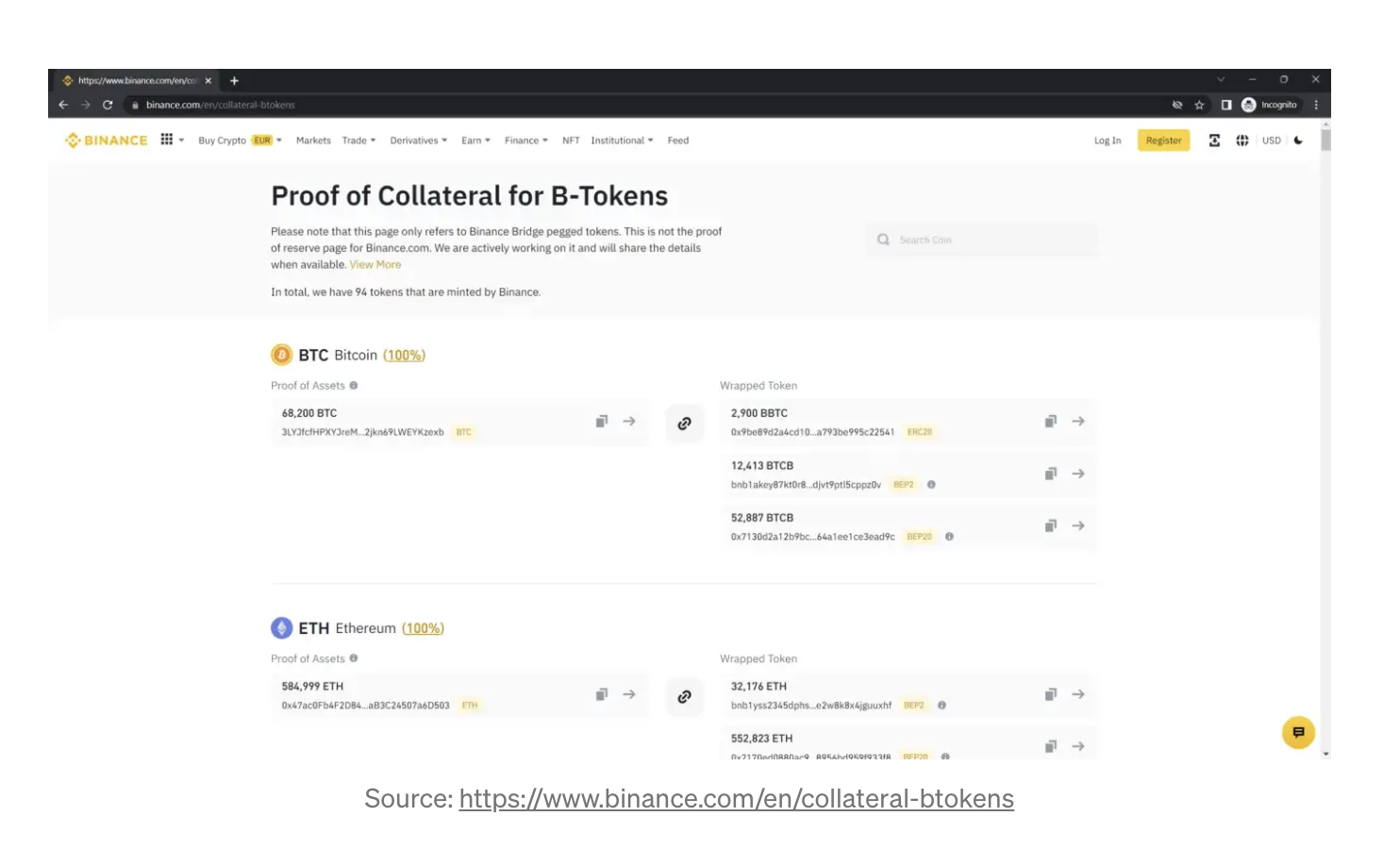
Binance conveniently provides a “Proof of Collateral for B-Tokens” page to demonstrate that tokens it has “wrapped” on the BNB Beacon Chain and BNB Smart Chain, are backed by tokens in the Binance-Peg wallet.
In fact, Binance even explains the purpose of the page here:
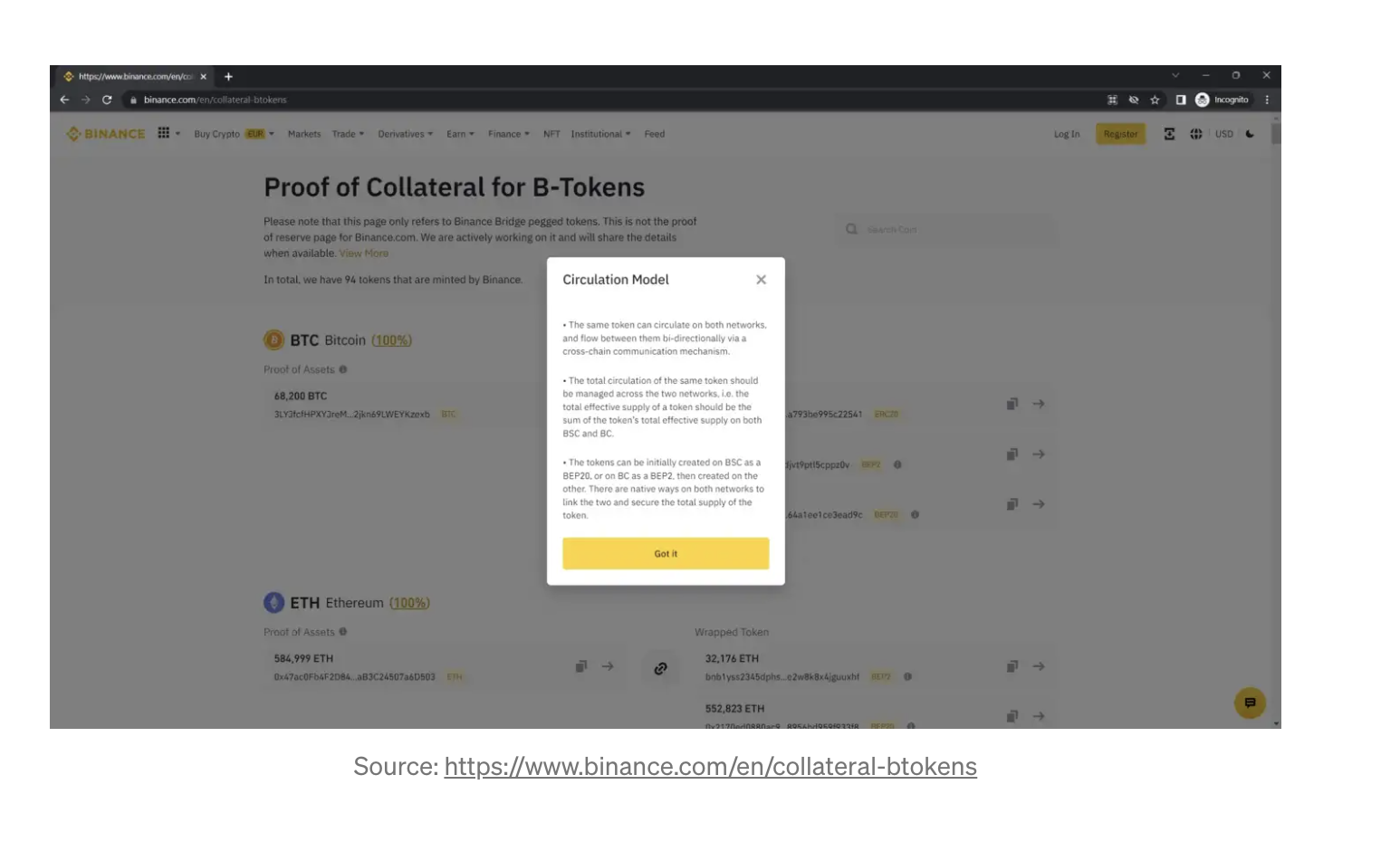
While Binance’s explanation of its “Circulation Model” is unnecessarily complex, suffice to say that the purpose of its “Proof of Collateral for B-Tokens” webpage is intended as a means to show that whatever tokens have been wrapped, are backed by the same amount on the blockchain that that token originated.
Binance has also conveniently put in the percentage by which that “wrapped” token is backed as well and the tokens are all fully or overcollateralized.
It’s important at this juncture to understand how Binance-Peg tokens work.
Whose Wallet is it Anyway?
There is a specific wallet address that is tagged as a “Binance-Peg” and the tokens deposited there are intended to back the “wrapped” tokens on Binance’s various blockchains, BNB Beacon Chain and BNB Smart Chain.
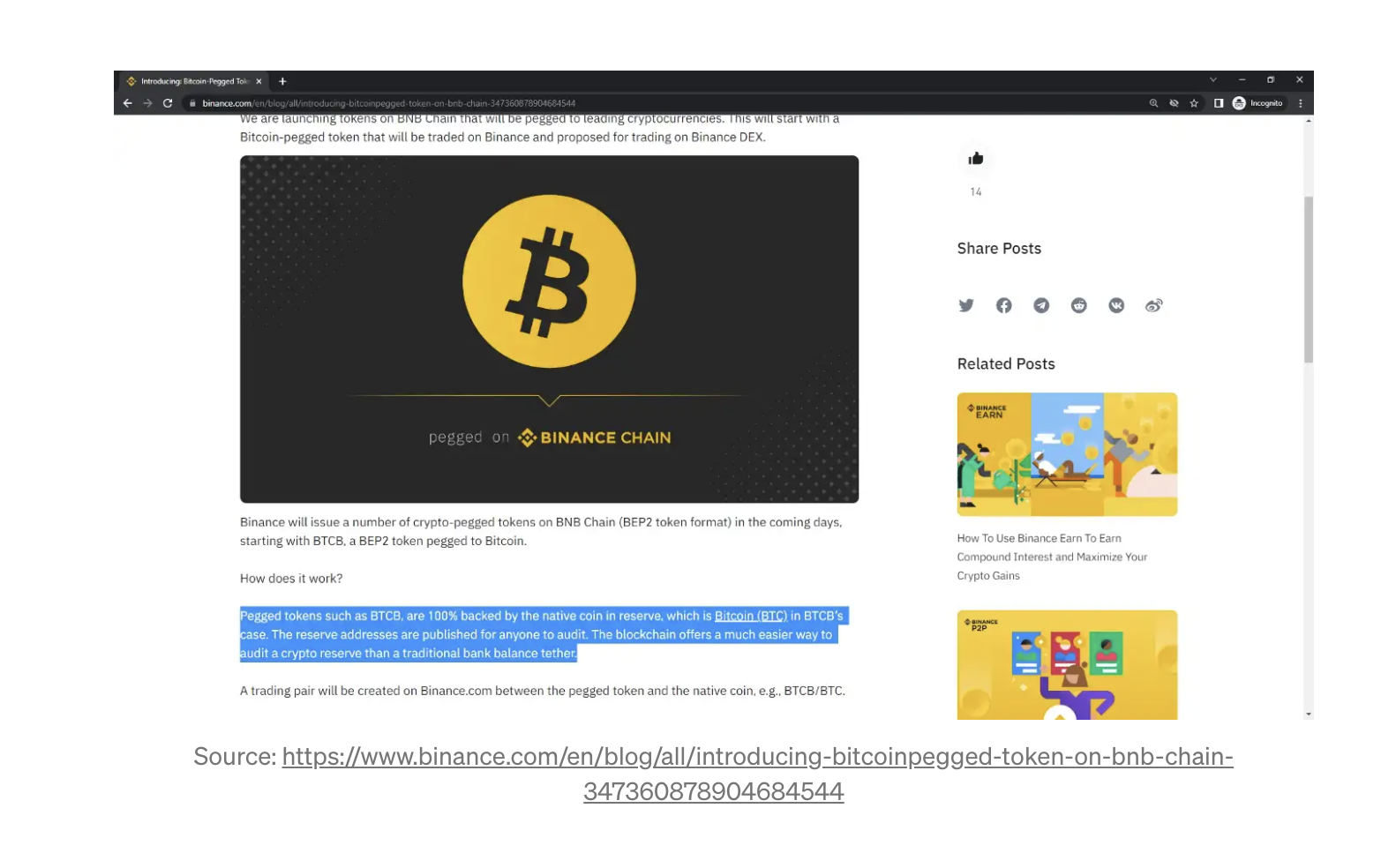
The same system was applied to BUSD and a slew of other tokens that have Binance-Peg wallets.
Now to the “Proof of Collateral for B-Tokens” page and the myriad issues that page contains.
Take DAI for instance, an algorithmic stablecoin.
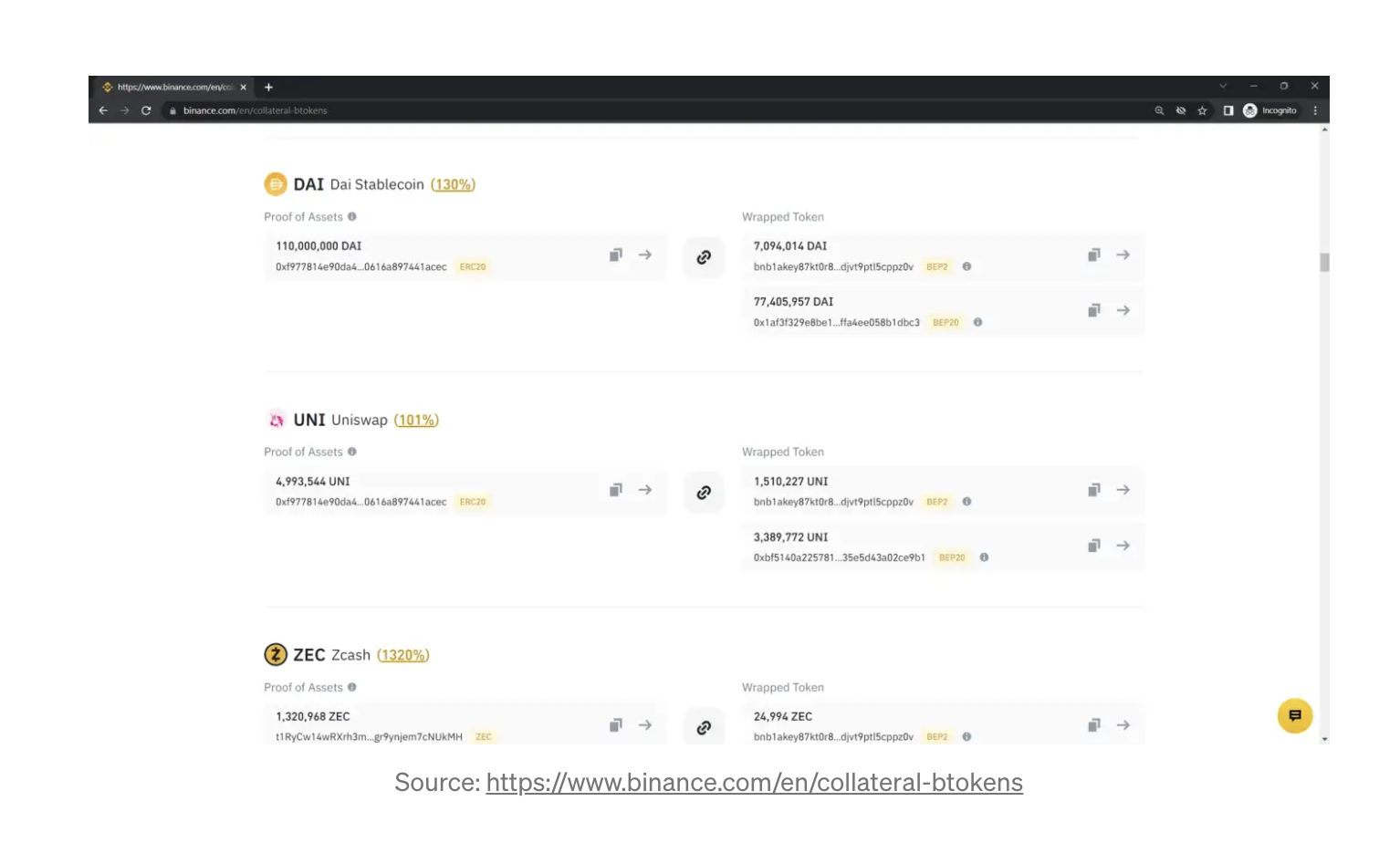
According to the “Proof of Collateral for B-Tokens” Binance has locked 110 million DAI in an Ethereum address ending “acec” which presumably is the Binance-Peg wallet, except it’s not.
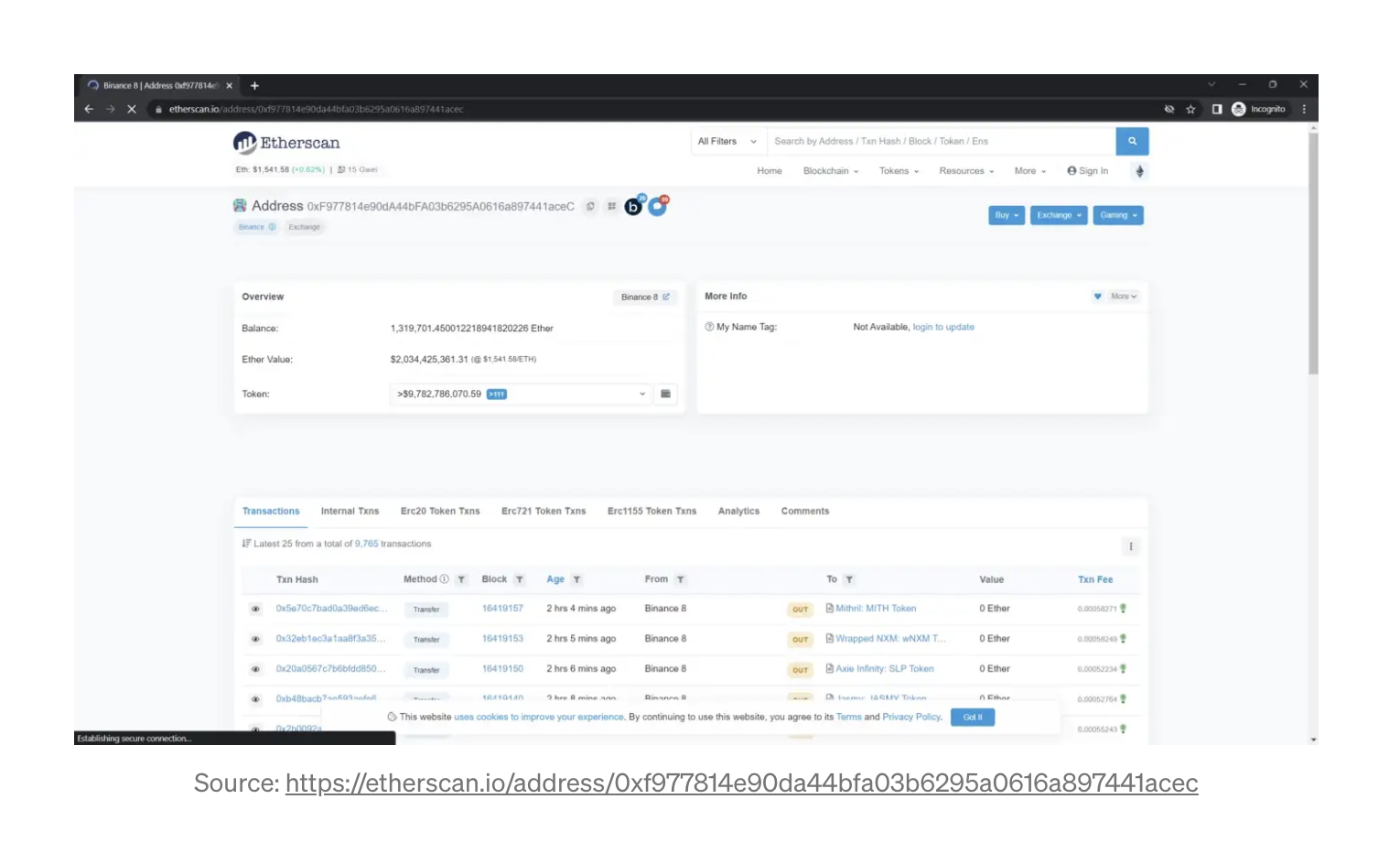
Instead, the wallet represented as the “Binance-Peg” wallet for DAI is a well-known and tagged Binance exchange wallet known as “Binance 8.”
So even though Binance claims that 110 million DAI in its Binance 8 wallet are collateralizing 7,094,014 DAI on its BNB Beacon Chain and 77,405,957 DAI on its BNB Smart Chain, the DAI backing the “wrapped” tokens isn’t in the “Binance-Peg” wallet but an exchange wallet.
Even though DAI is “overcollateralized” in that case by 130%, what exactly is it “overcollateralized” by?
Does the DAI in Binance 8 belong to the exchange’s users?
The same issue arises for UNI as well, the address listed as the “Binance-Peg” wallet actually belongs to the exchange and identified as Binance 8.
In total, there are no less than 41 different tokens, including Paxos USDP, where the Binance 8 wallet is proffered as the “Binance-Peg” wallet, when in fact, it is not.
We know that Binance does have a Binance-Peg wallet because Ether is placed in that wallet with the address ending in “D503” as is USDC.
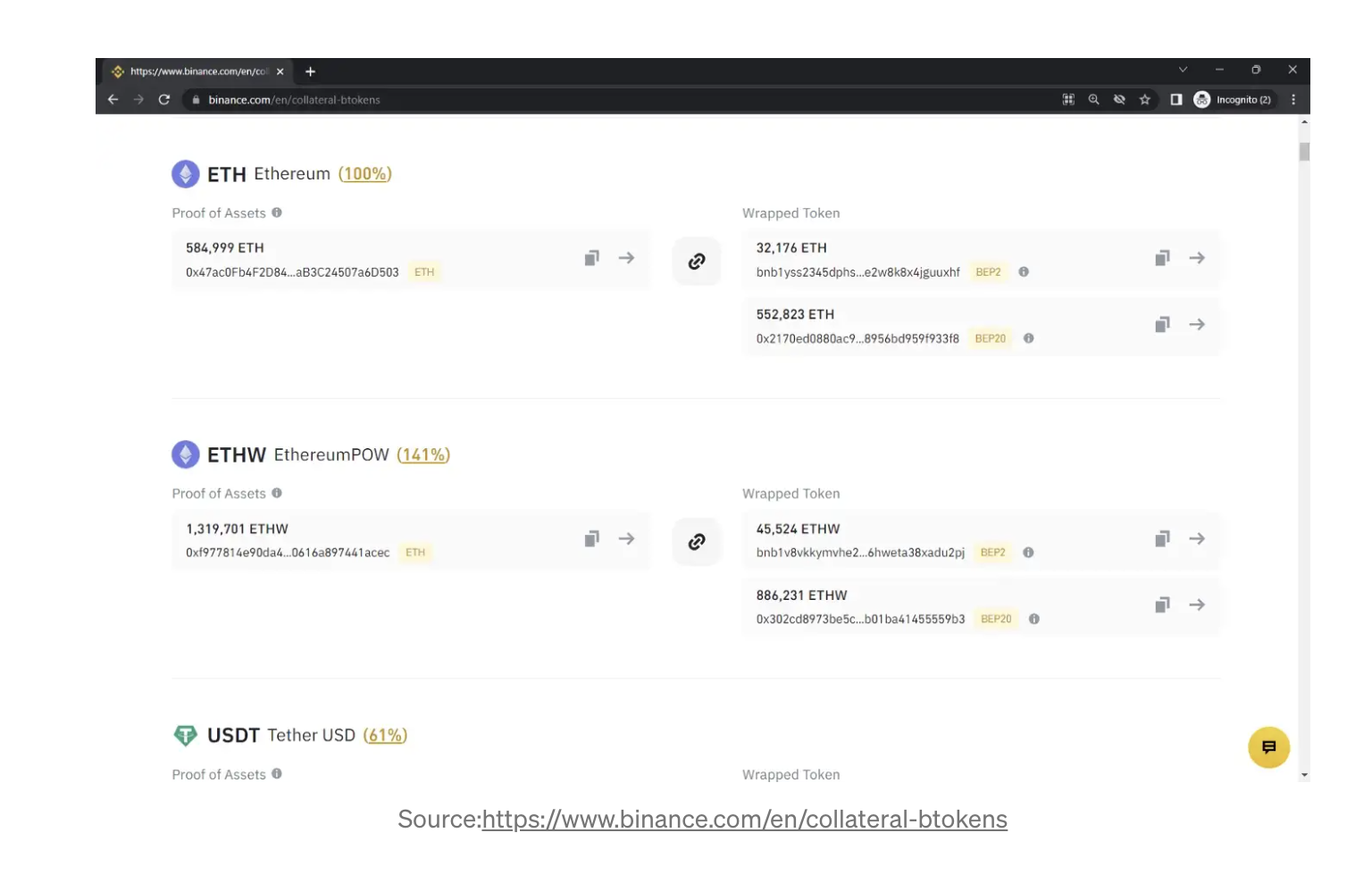
Even Forbes, which is owned by Binance, points out that both Binance 8 and the Binance-Peg wallets are distinct wallets.
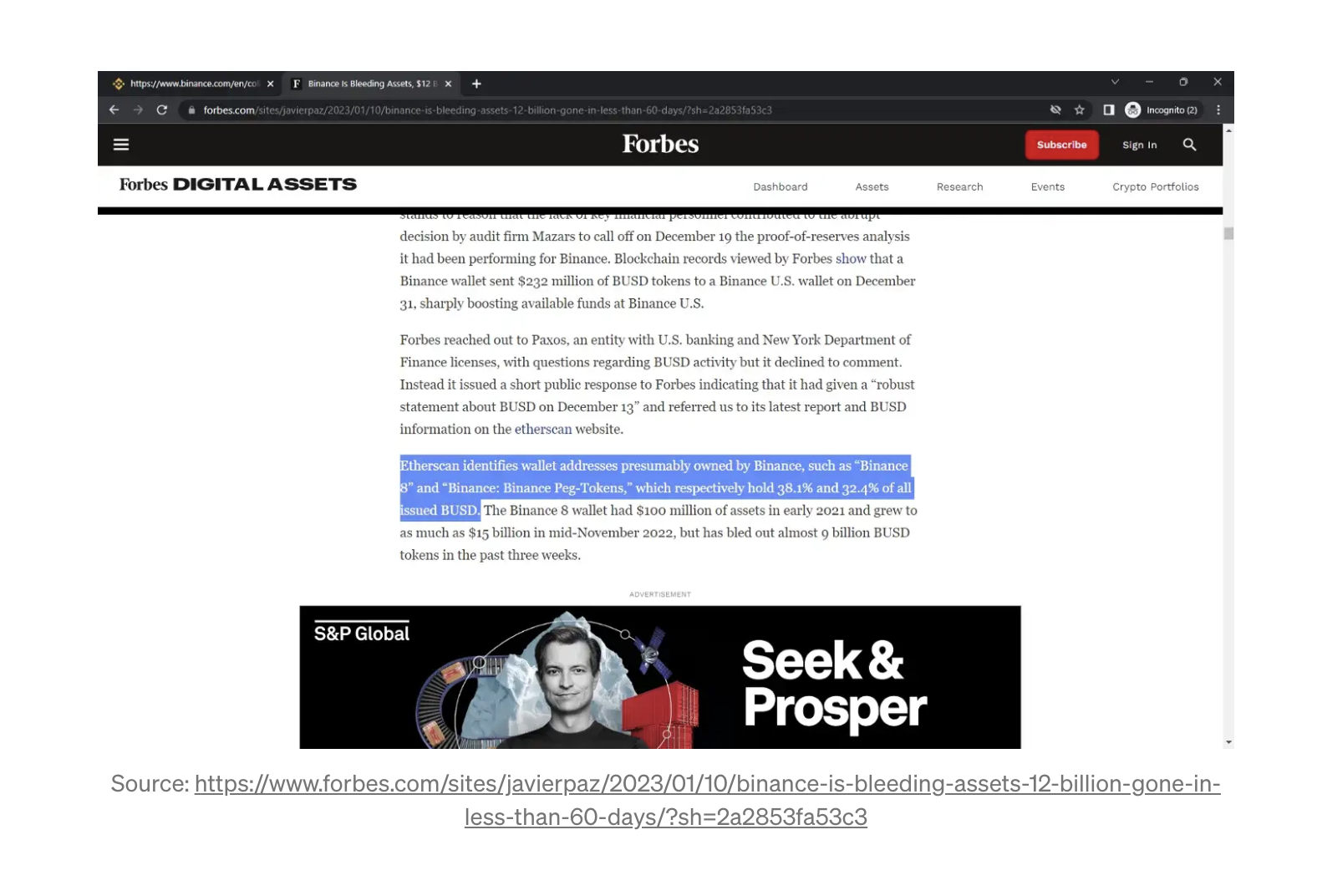
Which can mean only one of two things — either Binance 8 is a quasi-Binance-Peg wallet, where all sorts of assets are mixed, or Binance is using user funds to represent them as part of the collateralization for its wrapped tokens.
Although it may be tempting to dismiss this as another one of Binance’s (many) administrative issues, the problem of course is that Binance 8 doesn’t just hold “peg” tokens, it does a lot more, which is why it was never labeled a “Binance-Peg” wallet.
How to Make a Token Stew
On November 26, 2022, in the aftermath of the FTX collapse, Binance CEO Changpeng Zhao or “CZ” as he prefers to be known, responded to concerns over his exchange by claiming that user assets were held in separate wallets from those containing exchange assets.
But Binance 8 is a unique wallet in that if it was ever designated as a “Binance-Peg” wallet, it’s also been and continues to be, used for a whole range of activities, including to hold assets of the exchange itself.
In a blog post immediately after FTX imploded, Binance listed a slew of wallet addresses to prove reserves of the exchange, and one of those wallet addresses included, was the one ending with “acec” — Binance 8.
So is the “acec” or Binance 8 wallet a Binance-Peg wallet or an exchange wallet or whatever kind of wallet it could be when convenient?
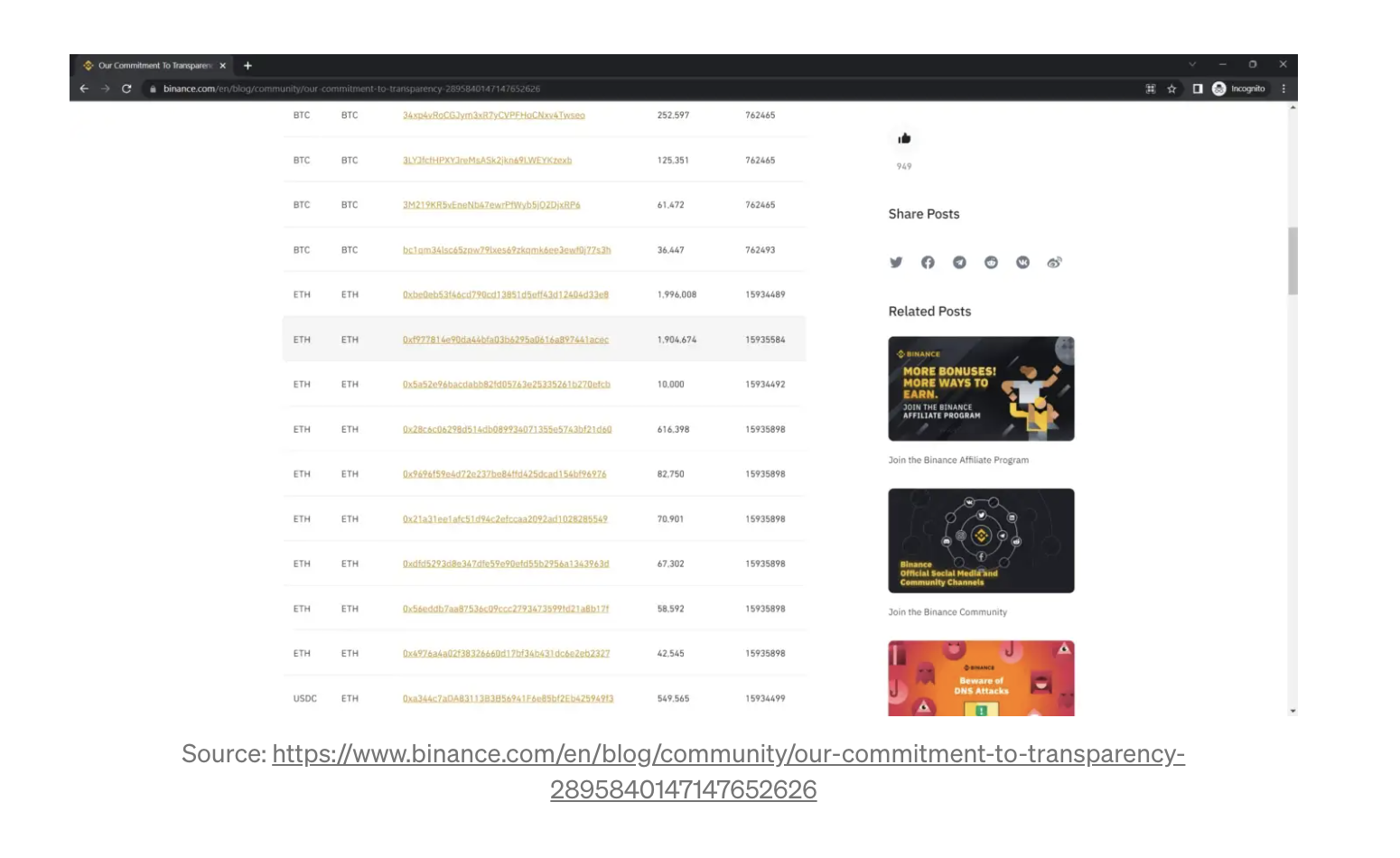
Pick a Wallet, Any Wallet
A wallet can’t both be a “Proof of Reserves” wallet and a “Binance-Peg” wallet, because the reserves are intended to show users that the exchange has all its assets where it says they are, and a peg wallet does something entirely different, allowing users to use the same token on another blockchain, in this case the BNB Beacon Chain and the BNB Smart Chain.
And that could go some way towards explaining why many of the Proof of Collateral B-Token addresses on Ethereum that Binance has in the “acec” wallet (Binance 8) are so heavily overcollateralized — some (or all) of that may belong to exchange users.
Because Binance didn’t use the Binance-Peg wallet in the case of so many of these tokens that it claims as B-Token collateral, it’s impossible to tell what the situation is because the exchange isn’t following the procedures it set for itself.
And to make matters worse, there are plenty of occasions when the designated Binance-Peg wallet was grossly undercollateralized versus the circulating supply on the BNB Smart Chain even beyond what was discovered with respect to BUSD.
Collateralize This?
Take USDC for instance, a regulated stablecoin issued by Circle, which received its first BitLicense issued by the New York State Department of Financial Services.
On Circle’s website, a list of blockchains that USDC is available on is listed and which includes Ethereum, Solana, Avalanche, TRON, Algorand, Stellar, Flow and Hedera:
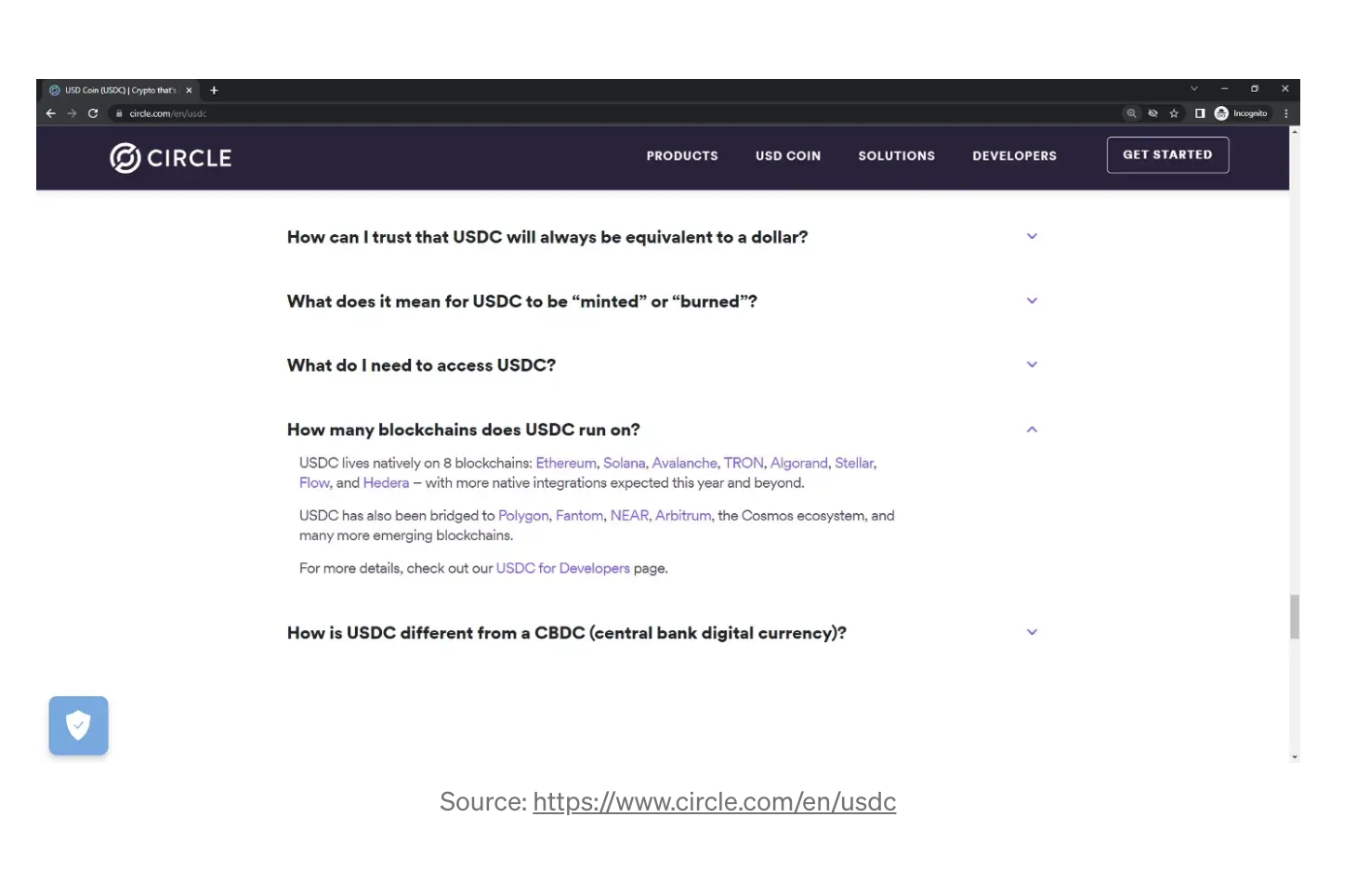
Circle also indicates that the only bridges it recognizes are on Polygon, Fantom, NEAR and Arbitrum — nothing is mentioned about Binance-Peg wallets or the BNB Smart Chain.
Nevertheless, USDC has been bridged on the BNB Smart Chain through the Binance-Peg wallet mechanism and the same sort of behavior with respect to minting USDC for use on the BNB Smart Chain as was witnessed with BUSD is seen once more.
Comparing the Ethereum Binance-Peg wallet for USDC, which is where the USDC should sit to back the equivalent on the BNB Smart Chain, once again USDC is minted on the BNB Smart Chain well in advance of filling the Ethereum wallet with the USDC.
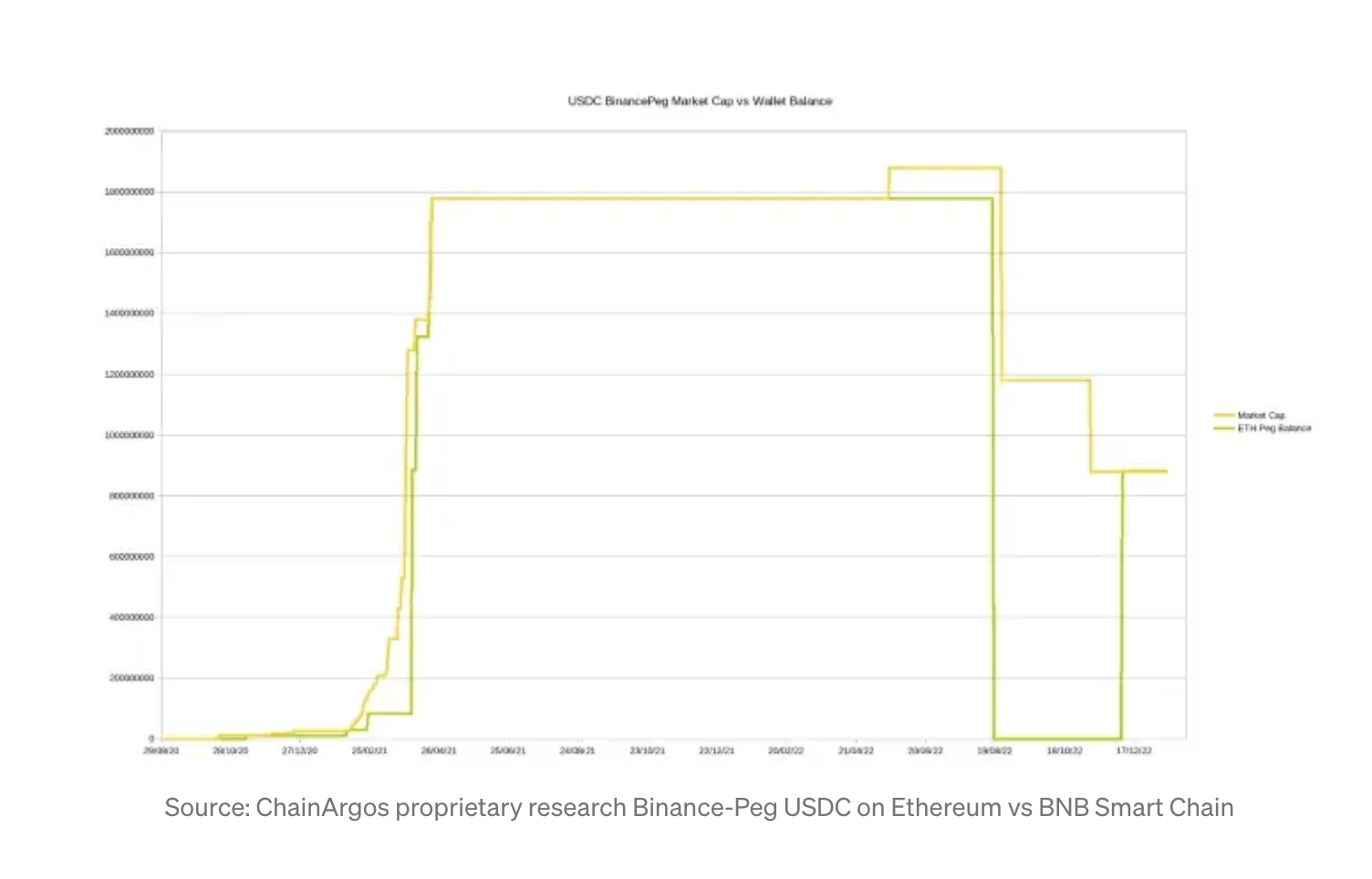
The yellow line in the chart above shows how USDC on BNB Smart Chain was minted and then the Binance-Peg wallet balance was filled up later.
And then in the autumn of 2022, something dramatic happenned — in a transaction tracked by ChainArgos, Binance entirely drained the Binance-Peg wallet on Ethereum for USDC on August 17, 2022, transferring out some US$1.779 billion.
And over the next several months, some US$1 billion of Binance-Peg USDC was burned, when in this transaction on December 6, 2022, about US$883 million worth of USDC are sent back into the Binance-Peg wallet, matching the circulating supply on the BNB Smart Chain.
For around 100 days, BNB Smart Chain USDC was entirely unbacked to the tune of some US$1 billion, which seems to suggest that someone or some people may have taken out a loan on this USDC and repaid it back somehow, but it’s not entirely clear what happened.
There is an evidence from the blockchain that these transactions were manual and perhaps even more disconcertingly, very recent.
The same issues are witnessed for the TUSD stablecoin as well, again, with Binance minting on BNB Smart Chain in excess of what’s in the Binance-Peg wallet and then somehow finding the money and stuffing it back in.
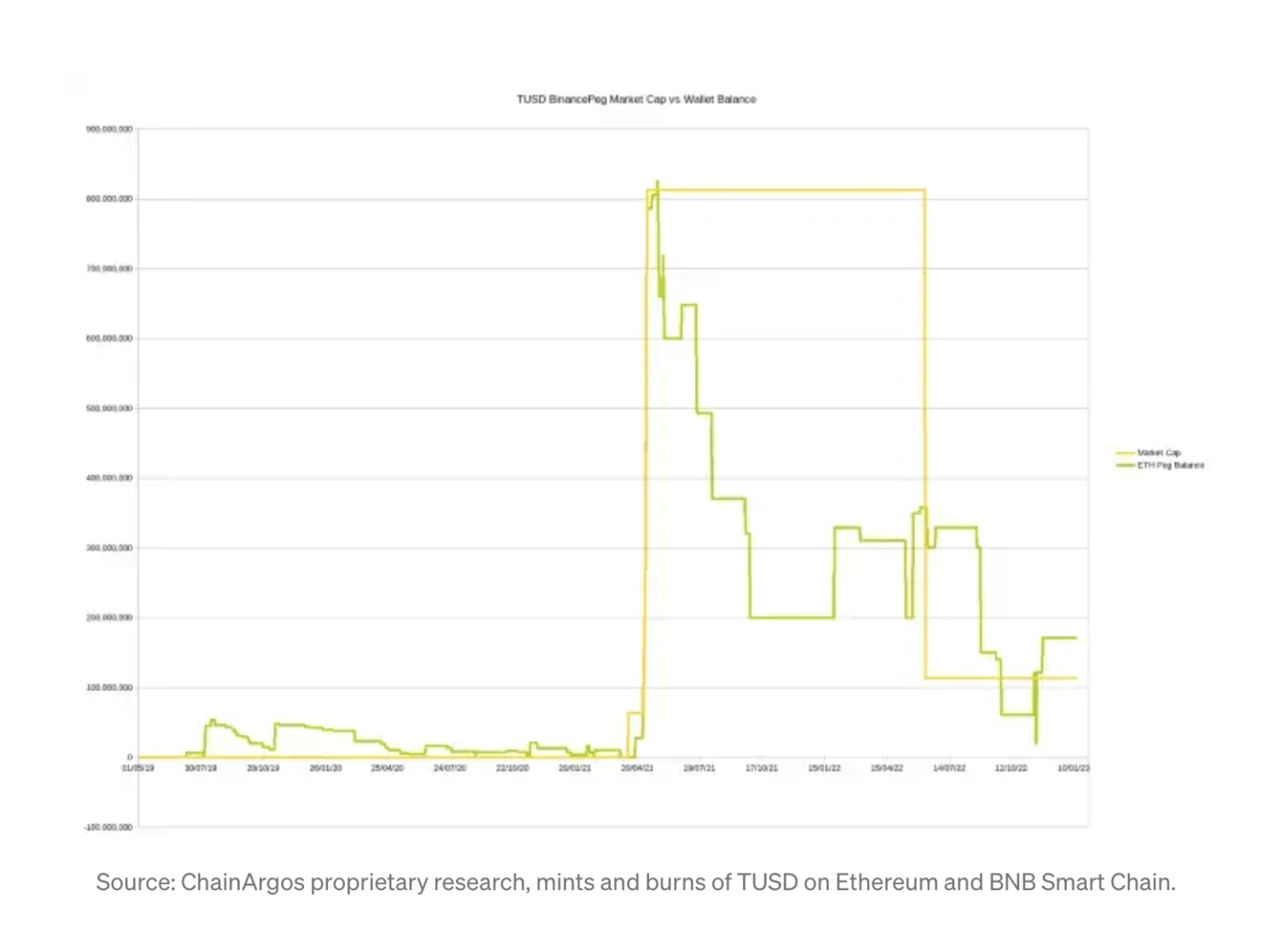
What’s in Your Wallet?
But perhaps even more alarming with the TUSD attestation is that the wallet being proffered as Proof of Collateral B-Tokens isn’t even the Binance-Peg wallet, it’s an exchange wallet — Binance 8.
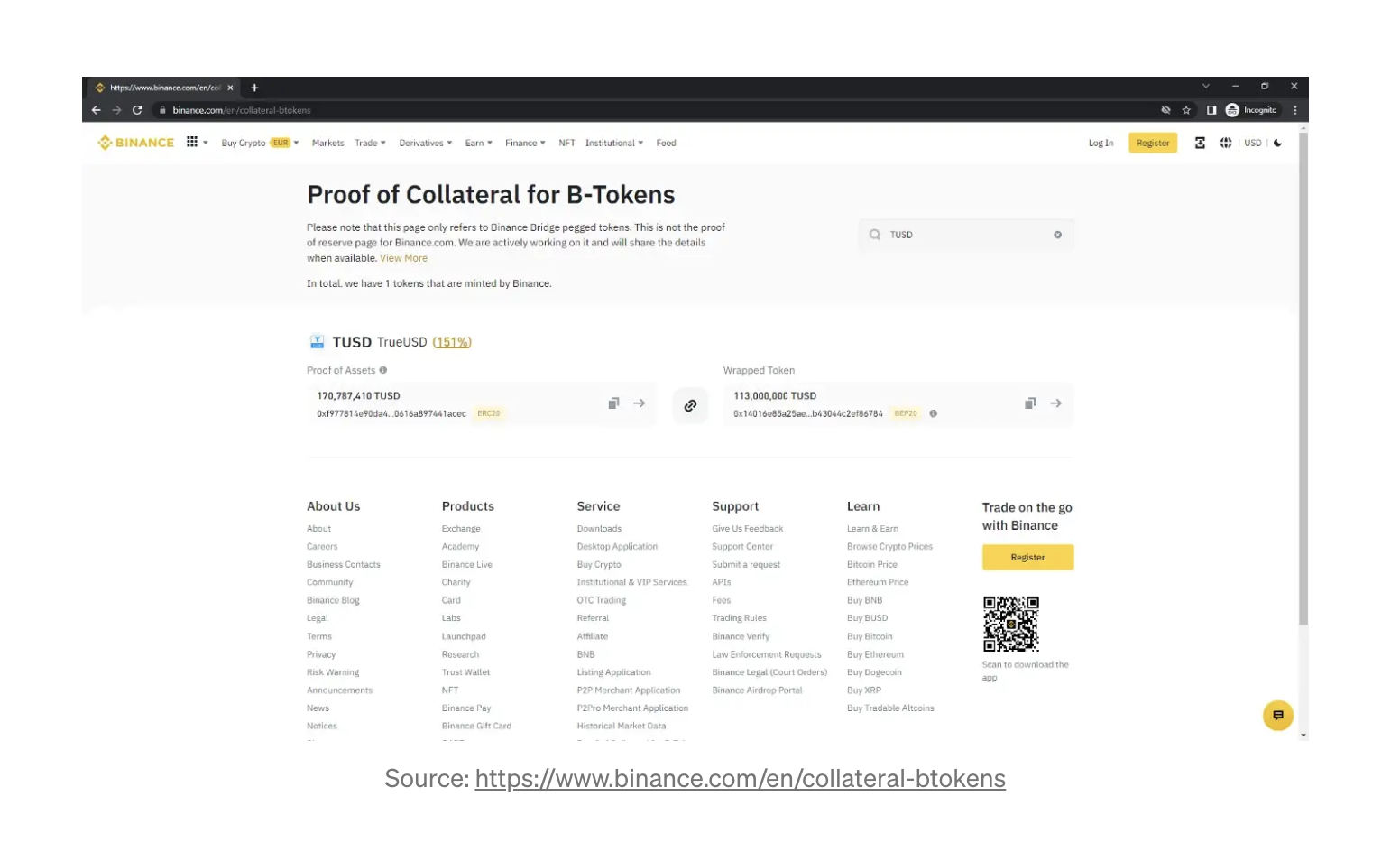
Again, the reason why TUSD may be so overly collateralized is because the Binance 8 wallet possibly contains funds belonging to exchange users.
There are numerous other examples of Binance 8 being used to represent Binance-Peg tokens (too numerous to run through individually) but perhaps one of the most alarming is for Tezos.
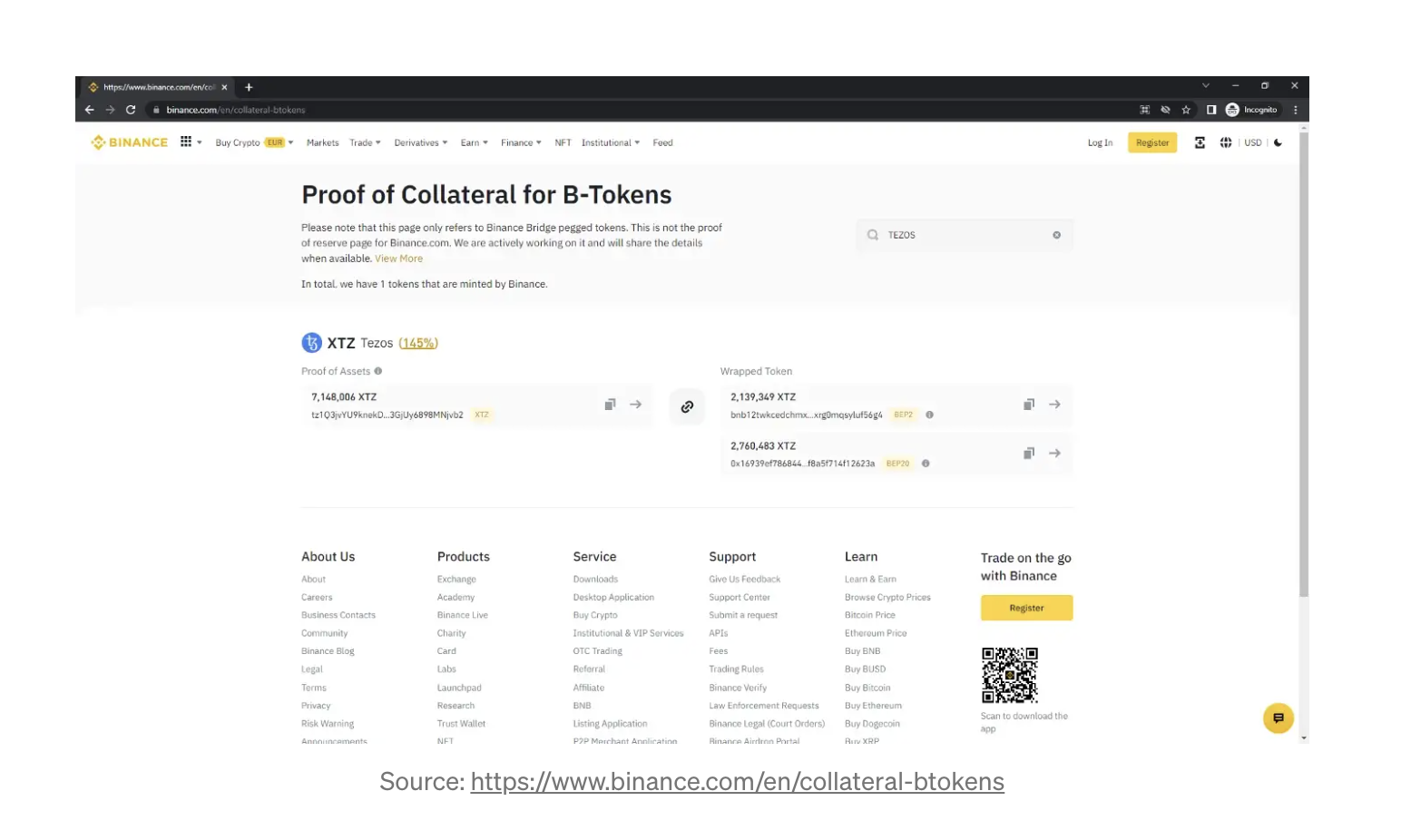
The Tezos wallet address that Binance offers as Proof of Collateral for B-Tokens isn’t just not a Binance-Peg wallet, it’s a Binance wallet staking address on Tezos known as “Binance Delegator 2.”
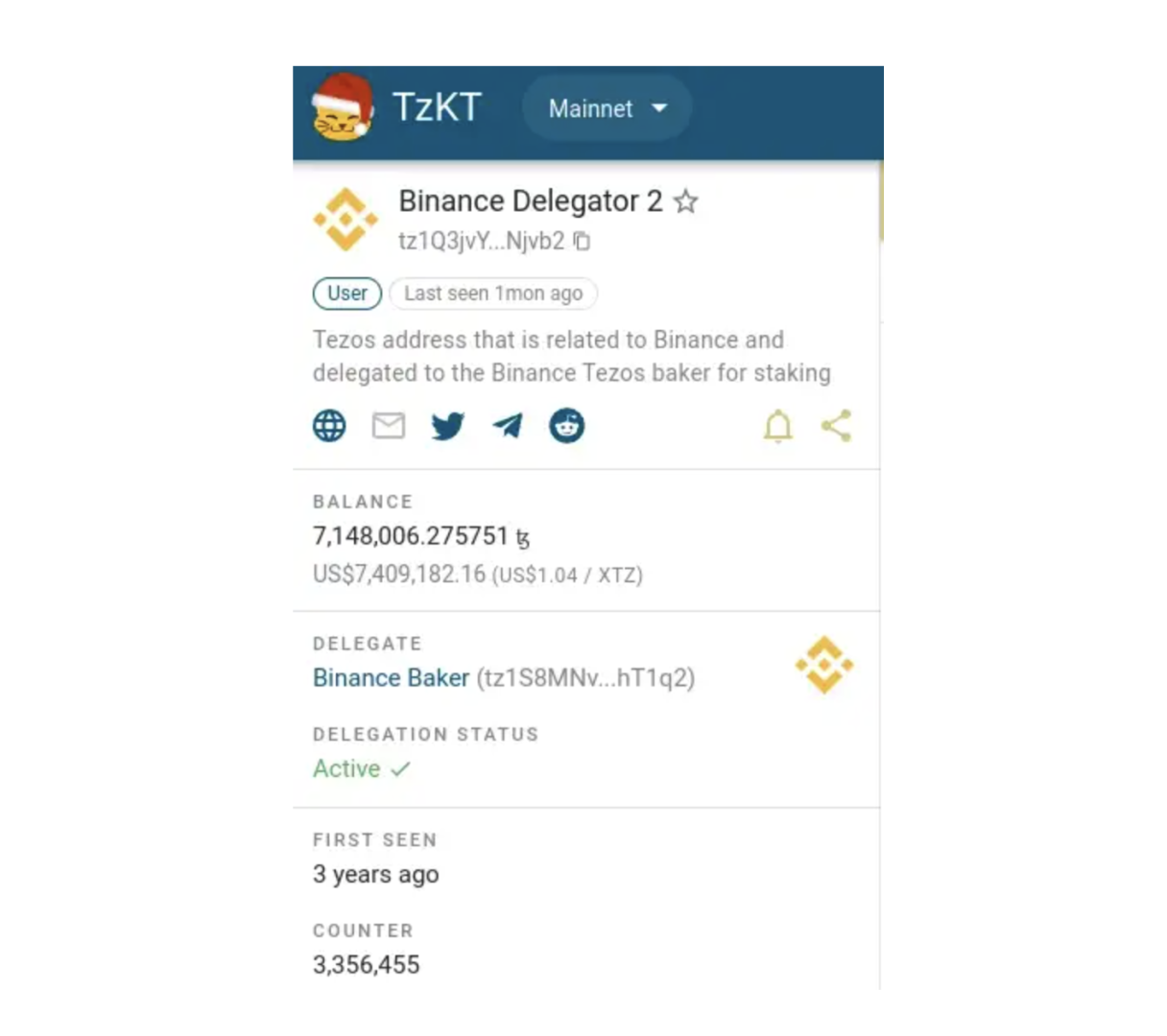
For the unfamiliar, nothing could be further from a “proof of collateral” wallet like a staking wallet address because by acting as a validator on Tezos, the funds in the Binance Delegator 2 could be subject to slashing.
For instance, if a validator on Tezos stands idle for a long time, this violates the integrity of the entire blockchain and Tezos punishes the validator by charging a fine.
Regardless, the Tezos wallet that Binance offers as a proof of collateral is anything other than a Binance-Peg wallet.
Despite a Binance spokesperson telling Bloomberg,
“Recently, the process has been much improved with enhanced discrepancy checks to ensure it’s always backed 1–1.”
it’s hard to see what these “discrepancy checks” were given the multitude of inconsistencies across the very pages that Binance wants users to examine.
The blockchain data proves that Binance has been playing fast and loose with its wallets that it’s using both for its proof of reserves, and for its collateralization of B-Tokens for use on the BNB Beacon Chain and BNB Smart Chain.
At best, Binance could be said to be sloppy, at worst, well, let’s leave it at that.
But we’ve all seen what happens when a cryptocurrency exchange doesn’t follow the procedures and policies that it sets for itself.
And while we’re not saying that Binance is insolvent, it’s very hard to tell what its state is — the same wallets are being used to attest reserves and collateralization simultaneously.
The Binance 8 wallet for instance was used to demonstrate both proof of reserves and collateralization of B-Tokens.
Binance has also demonstrated a habit of minting stablecoins on BNB Smart Chain well ahead of collateralizing them and a shocking willingness to leave them completely uncollateralized for extended periods of time.
It’s somewhat surprising that the very pages Binance would have users look at to provide comfort actually raise more questions than they answer.
Which wallets are these? Whose funds are in them and why are the same wallets being used for different attestations?
Are exchange funds being commingled with Binance funds and Binance-Peg wallets?
These and other questions remain painfully unanswered and where attempted to be answered, the answers have proved thoroughly inadequate and unsatisfactory.
But perhaps most worrying of all is that Binance itself may not necessarily know the answers.
Trending
-
1 Building a Strong Financial Foundation: Saving, Investing, and Retirement Planning
Daniel Hall -
2 Franchise Investment Pitfalls to Avoid: A Beginner's Checklist
Daniel Hall -
3 Why Selling to an iBuyer Could Be the Best Move for Your Home
Daniel Hall -
4 Financial Tips for Businesses: Reducing Expenses Without Sacrificing Quality
Daniel Hall -
5 9 Tips to Help You Secure a Graduate Job in Finance
Daniel Hall





Comments